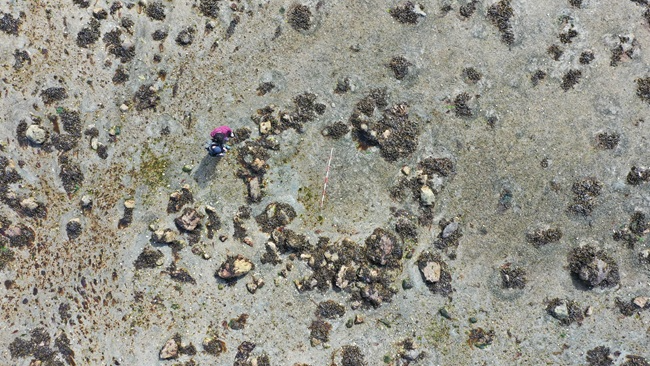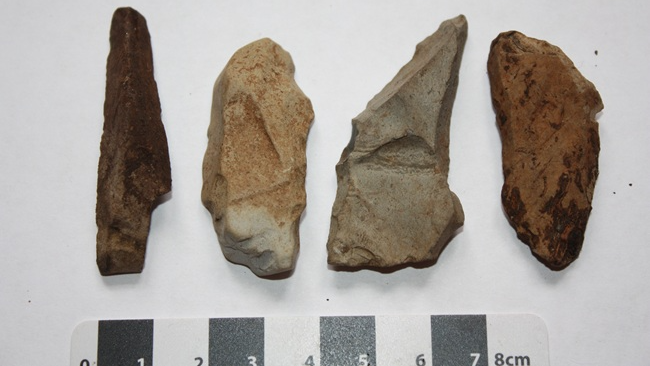'Ultimate adventure story': Submerged stone circles reveal perilous migration of prehistoric people to far northern Scotland 11,000 years ago
Stone tools and stone circles discovered in coastal Scotland show that prehistoric people settled farther north than anyone previously believed.

The discovery of submerged stone circles and Stone Age tools on the Isle of Skye reveals that humans occupied what is now northern Scotland about 11,000 years ago.
The finding indicates that these people braved a volatile landscape of glaciers and fluctuating coastlines in northern Scotland, venturing much farther north than experts once believed.
"This is a hugely significant discovery which offers a new perspective on the earliest human occupation yet known, of north-west Scotland," Karen Hardy, a prehistoric archaeologist at the University of Glasgow, said in a statement. Hardy and colleagues published a study of two archaeological sites on the Isle of Skye in the Journal of Quaternary Science in April.
Until recently, little was known about the earliest settlements in Scotland, due to factors such as sea-level rise and the lack of organic remains to radiocarbon-date archaeological sites there, the researchers noted in the study.
But Hardy and colleagues' discovery of numerous stone tools shaped into points, blades and scrapers in a style called Ahrensburgian — which was in use across north-central Europe during the Late Upper Paleolithic — has provided evidence that hunter-gatherers made their way across the forbidding Isle of Skye coastline more than 11,000 years ago.
Related: Was it a stone tool or just a rock? An archaeologist explains how scientists can tell the difference

The researchers also found several stone circles between 10 and 16 feet (3 to 5 meters) in diameter in the tidal area of a second archaeological site. Boulders measuring roughly 1.6 feet (0.5 m) in diameter were embedded in the clay bottom of the beach to form a circle.
Get the world’s most fascinating discoveries delivered straight to your inbox.
Because of sea-level rise, these stone circles "are only visible at the extreme spring tides and are exposed around 2-3 hours per year," they wrote in the study, but the circles were likely terrestrial features when they were constructed.
By estimating the timing of glacier retreat and sea-level rise, the researchers determined that the only time these stone circles could have been created would have been around 11,000 years ago, during a period of volatile climate change as the glaciers rapidly melted at the end of the last ice age. This time frame fits with similar stone circles found in Norway that have been dated to 11,000 to 10,500 years ago and are thought to be the remains of a hide-covered tent or hut, the team said.
Around the same time, the lower sea level also would have opened up a land bridge or terrestrial corridor between the southern part of the Isle of Skye and mainland Scotland. Ancient people likely would have used this passageway when migrating northwest from what are today Germany and Belgium. Today, this swath of land connecting Great Britain to continental Europe is known as Doggerland, but it's now under the North Sea.
"To reach north-west Scotland would have involved complex travel across unfamiliar terrain, comprising steep mountains and large bodies of water," the researchers wrote, possibly in pursuit of deer and other large mammals.
Living in Skye 11,000 years ago required ancient people to adapt quickly to a rapidly changing climate and environment, according to the researchers. But the abundant stone tools and curious circles suggest a decent-sized group of people stuck it out for the long term and settled into their new coastal life.
"The journey made by these pioneering people who left their lowland territories in mainland Europe to travel northwards into the unknown is the ultimate adventure story," Hardy said.
Stone Age quiz: What do you know about the Paleolithic, Mesolithic and Neolithic?

Kristina Killgrove is a staff writer at Live Science with a focus on archaeology and paleoanthropology news. Her articles have also appeared in venues such as Forbes, Smithsonian, and Mental Floss. Kristina holds a Ph.D. in biological anthropology and an M.A. in classical archaeology from the University of North Carolina, as well as a B.A. in Latin from the University of Virginia, and she was formerly a university professor and researcher. She has received awards from the Society for American Archaeology and the American Anthropological Association for her science writing.
You must confirm your public display name before commenting
Please logout and then login again, you will then be prompted to enter your display name.


